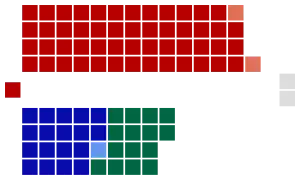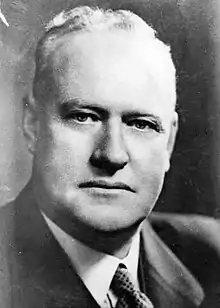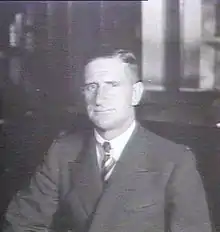1947 New South Wales state election
The 1947 New South Wales state election was held on 3 May 1947. It was conducted in single member constituencies with compulsory preferential voting and was held on boundaries created at a 1940 redistribution. The election was for all of the 90 seats in the Legislative Assembly.
| |||||||||||||||||||||||||||||||
All 90 seats in the New South Wales Legislative Assembly 46 Assembly seats were needed for a majority | |||||||||||||||||||||||||||||||
|---|---|---|---|---|---|---|---|---|---|---|---|---|---|---|---|---|---|---|---|---|---|---|---|---|---|---|---|---|---|---|---|
| |||||||||||||||||||||||||||||||
 Legislative Assembly after the election | |||||||||||||||||||||||||||||||
| |||||||||||||||||||||||||||||||
Issues
At the beginning of 1947, Labor had been in power for 6 years under the premiership of William McKell. The urban conservative parties, which had been in a state of disarray at the previous election in 1944 had been unified as the Liberal Party of Australia under the federal leadership of Robert Menzies. However, in New South Wales the state Liberals had lost their two most experienced and capable leaders, Reginald Weaver who had died in November 1945 and Alexander Mair who had resigned from parliament to unsuccessfully contest a NSW senate seat at the 1946 federal election. They had been led by Vernon Treatt since March 1946. In February 1947, 3 months before the election was due, McKell stunned most people in the Labor Party and general community by announcing that he would resign to take up the position of Governor-General. McKell's preference as a successor was his ally in the struggle against Jack Lang, Bob Heffron. However, revealing the residual influence of Lang, the caucus chose his preferred candidate, the Housing Minister, James McGirr. Both parties went to the election with untried leaders. However, residual respect for McKell, continuing economic growth, the popularity of the federal Labor government and the memory of the factional fights among the state's conservative politicians gave Labor a significant advantage in the campaign.[1]
Key dates
| Date | Event |
|---|---|
| 6 February 1947 | First McGirr ministry sworn in. |
| 29 March 1947 | The Legislative Assembly was dissolved, and writs were issued by the Governor to proceed with an election. |
| 3 April 1947 | Nominations for candidates for the election closed at noon. |
| 3 May 1947 | Polling day. |
| 19 May 1947 | Second McGirr ministry sworn in. |
| 27 May 1947 | Last day for the writs to be returned and the results formally declared. |
| 28 May 1947 | Opening of 35th Parliament. |
Results
While Labor lost some of the traditionally conservative seats it had picked up at the 1944 election to the Liberal Party, the result of the election was a landslide victory for Labor. Many of the gains of the Liberal and Country parties were conservative members who had been elected as independents at the previous election. They had rejoined the parties when some degree of order had been restored:
|
New South Wales state election, 3 May 1947 | ||||||
|---|---|---|---|---|---|---|
| Enrolled voters | 1,852,787[lower-alpha 1] | |||||
| Votes cast | 1,621,257 | Turnout | 94.61 | +3.19 | ||
| Informal votes | 32,262 | Informal | 1.99 | −1.14 | ||
| Summary of votes by party | ||||||
| Party | Primary votes | % | Swing | Seats | Change | |
| Labor | 730,194 | 45.95 | + 0.75 | 52 | −4 | |
| Liberal [lower-alpha 2][lower-alpha 3] | 485,286 | 30.50 | +5.34 | 19 | +7 | |
| Country | 162,467 | 10.22 | −0.19 | 15 | +5 | |
| Independent | 94,163 | 5.92 | +0.20 | 2 | −3 | |
| Lang Labor | 64,851 | 4.08 | −5.25 | 2 | − | |
| Communist | 27,237 | 1.71 | −0.03 | 0 | − | |
| Independent Labor | 13,917 | 0.88 | −0.91 | 0 | − | |
| Independent Liberal [lower-alpha 4] | 11,150 | 0.49 | -1.92 | 0 | −4 | |
| Protestant Labor | 3,361 | 0.21 | +0.21 | 0 | − | |
| Other | -4.50 | −1 | ||||
| Total | 1,589,265 | 90 | ||||
Retiring members
William McKell (Labor, Redfern) resigned in February 1947; no by-election was held due to the proximity of the election.
Labor
Seats changing party representation
Aftermath
McGirr, Treatt and Country Party Leader Michael Bruxner retained their leadership roles throughout the parliament.
There were 11 by-elections during the parliament with a net loss of 3 seats for Labor.
Notes
- There were 1,713,921 enrolled voters in 82 contested electorates and 138,866 were enrolled in 8 uncontested electorates (5 Labor and 3 Country). [2]
- Includes Doug Padman (Albury) and Ray Bladwell (Goulburn) who were jointly endorsed by the Liberal and Country parties.
- Swing and change are compared to the Democratic Party at the 1944 election.
- Swing and change are compared to Independent Democrat at the 1944 election.
- John Hurley (Labor) had won the seat at the 1946 Corowa by-election caused by the resignation of former Premier Alexander Mair (Liberal).
- Ebenezer Kendell (Country) had won the seat at the 1946 Corowa by-election caused by the resignation of Independent Christopher Lethbridge.
- Douglas Darby (Liberal) won the seat at the 1945 Manly by-election caused by the death of Independent Democrat turned Liberal Alfred Reid.
- Joseph Jackson (Nepean) was re-elected in 1944 as Independent Democrat candidate and later joined the Liberal Party.
- Eric Hearnshaw (Liberal) had won the seat at the 1945 Ryde by-election caused by the death of Independent James Shand.
References
- McMullin, Ross (1991). The Light on the Hill: The Australian Labor Party 1891-1991. Oxford University Press. pp. 244–5. ISBN 0-19-554966-X.
- Green, Antony. "1947 election totals". New South Wales Election Results 1856-2007. Parliament of New South Wales. Retrieved 31 July 2019.

